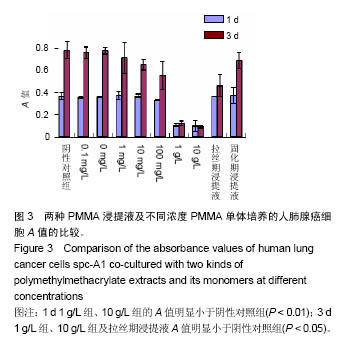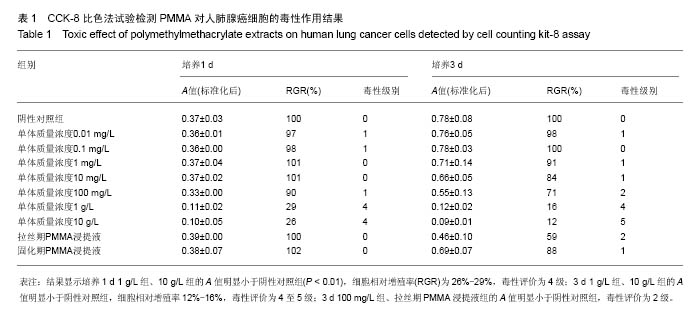中国组织工程研究 ›› 2017, Vol. 21 ›› Issue (2): 187-191.doi: 10.3969/j.issn.2095-4344.2017.02.005
• 组织工程骨及软骨材料 tissue-engineered bone and cartilage materials • 上一篇 下一篇
聚甲基丙烯酸甲酯骨水泥对肺癌细胞毒性作用的体外实验
潘元星,米 川,施学东,王 冰,崔云鹏,林云飞
- 北京大学第一医院骨科,北京市 100083
In vitro toxic effect of polymethylmethacrylate bone cement on lung cancer cells
Pan Yuan-xing, Mi Chuan, Shi Xue-dong, Wang Bing, Cui Yun-peng, Lin Yun-fei
- Department of Orthopaedics, Peking University First Hospital, Beijing 100083, China
摘要:
文章快速阅读:
.jpg)
文题释义:
聚甲基丙烯酸甲酯(PMMA)骨水泥:是一种重要的可塑性高分子材料,具有较好的透明性、化学稳定性、较高的抗张强度和可塑性,与人体组织有适应性,已广泛应用于骨科手术中,是椎体成形术中填充材料的主要成分。
细胞毒性:是由细胞或化学物质导致的细胞杀伤事件,是不依赖于凋亡或坏死的细胞死亡。实验采用的量化细胞毒性评价方法是cck-8比色法,细胞增殖越多越快,则颜色越深;细胞增殖越慢,则颜色越浅。通过测定细胞的吸光度(A)值计算细胞相对增殖率(RGR)来评价细胞毒性。
背景:经皮椎体成形是治疗脊柱转移瘤的一种微创手术方法,但术中注射的聚甲基丙烯酸甲酯(polymethylmethacrylate,PMMA)骨水泥对肿瘤的治疗机制目前尚不明确。
目的:分析PMMA骨水泥及其单体对肿瘤细胞的细胞毒作用。
方法:将固化期、拉丝期PMMA骨水泥的浸提液及不同质量浓度单体的稀释液与人肺腺癌细胞spc-A1接触培养1,3 d后,采用细胞形态直接观察法和CCK-8比色法测定细胞吸光度(A)值,计算细胞相对增殖率(RGR),评价PMMA骨水泥及其单体对肿瘤细胞的毒性。
结果与结论:①1 d 1 g/L组、10 g/L组的A值明显小于阴性对照组(P < 0.01);3 d 1 g/L组、10 g/L组及拉丝期浸提液A值明显小于阴性对照组(P < 0.05);②结果显示培养1 d 1 g/L组、10 g/L组的A值明显小于阴性对照组(P < 0.01),细胞相对增殖率为26%-29%,毒性评价为4级;3 d 1 g/L组、10 g/L组的A值明显小于阴性对照组,细胞相对增殖率12%-16%,毒性评价为4至5级;3 d 100 mg/L组、拉丝期PMMA浸提液组的A值明显小于阴性对照组,毒性评价为2级。③结果表明,拉丝期PMMA骨水泥浸提液及PMMA单体质量浓度为100 mg/L-10 g/L时对肿瘤细胞有明显的毒性,说明经皮椎体成形过程中拉丝期PMMA骨水泥注入椎体后其释放的单体可能对肿瘤细胞存在细胞毒作用。
中图分类号:




.jpg)